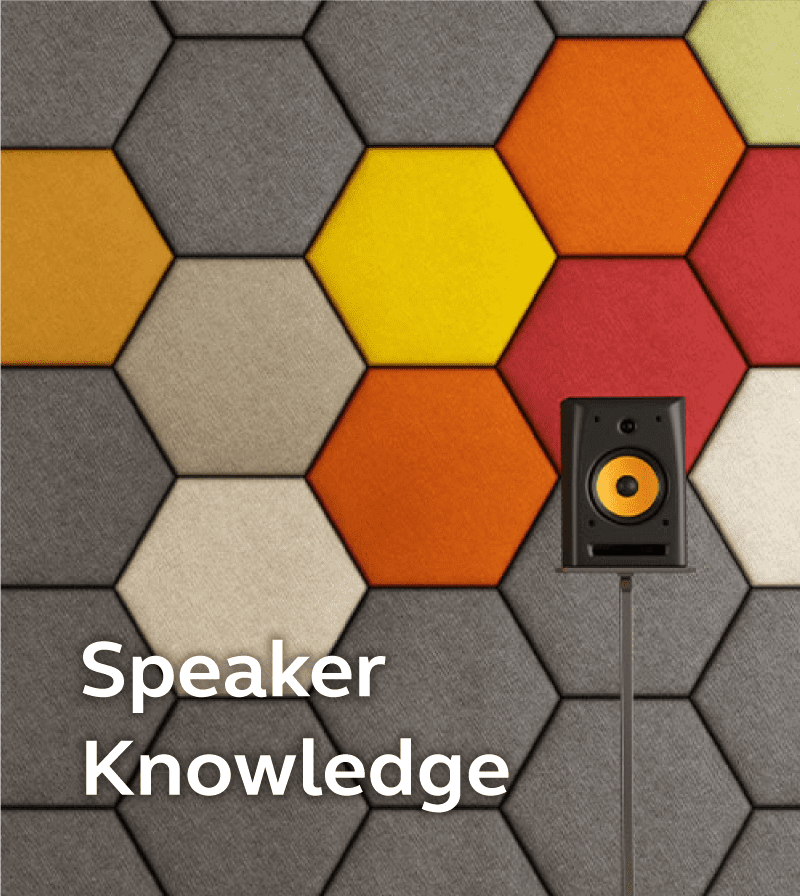
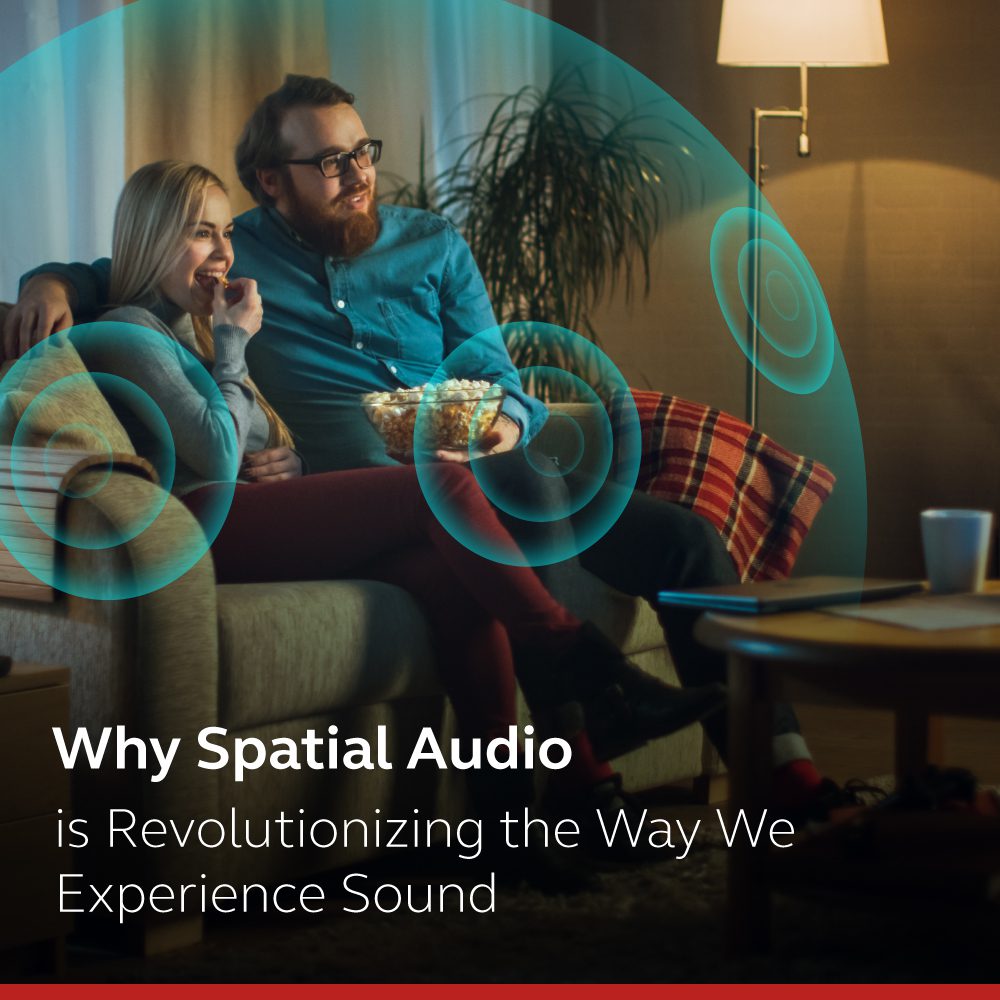
Defining Spatial Sound And Importance in Audio Technology
Spatial sound refers to audio technologies that enhance the perception of sound in 3D space. This technology allows listeners to identify the direction and distance of sound sources in a more immersive manner.
Traditional stereo sound, where audio is limited to two channels. But spatial sound can employ advanced techniques to create a more realistic sound environment. This creates a sense of presence, whether the listener is experiencing TV shows, gaming, cinema, and more. Spatial audio can be achieved through various methodologies, including binaural audio, multi-channel audio systems, and algorithmic processing techniques, which we will discuss in this article.
As consumers increasingly seek more immersive experiences, the demand for technologies that provide spatial sound has grown. Additionally, spatial sound plays a crucial role in professional audio production, where sound engineers can manipulate audio elements in 3D space for better mixing and mastering outcomes.
For more insights into the market, please check out our previous article: https://www.jazzhipster.com/next-wave-of-audio-technology-in-wireless-speaker-manufacturing/
JAZZ HIPSTER's Role in Spatial Sound
At JAZZ HIPSTER, we have positioned ourselves as a seasoned player in spatial audio. Our extensive experience allows us to effectively navigate the intricacies of spatial sound design and integration. We understand the technical challenges involved and have developed proactive solutions to address them throughout the product life cycle.
Our ODM capabilities enable us to facilitate seamless transitions for audio brands into the realm of spatial audio technologies. We have successfully collaborated with industry-leading companies like MTK and Dolby, aiding in the development of innovative products that leverage spatial audio. Our partnerships with prominent tech firms further solidify our commitment to providing comprehensive solutions that meet the evolving demands of consumer audio markets.
Over the years, we have completed the development and mass production of multiple models that incorporate our spatial audio expertise. This includes sophisticated designs that enhance sound localization, as well as production techniques that ensure consistent quality across various audio products.
Empowering Brands through Spatial Sound Technologies
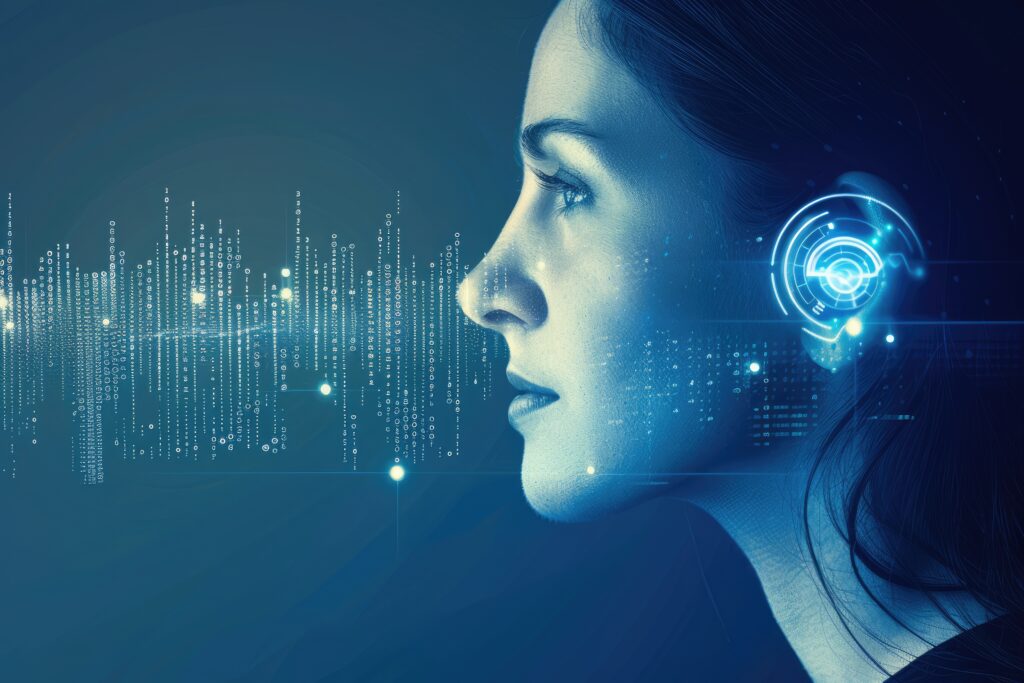
As an ODM speaker manufacturer, integrating spatial sound technologies is crucial for enhancing product capabilities and creating a competitive edge in the audio market. By adopting advanced audio solutions, brands can significantly enrich their products and resonate with consumers who desire immersive listening experiences.
This serves as a gateway to expand market potential and significantly boost product added value. Implementing spatial sound technology can open doors to new consumer segments, increase market share, and allow manufacturers to command premium pricing for enhanced audio experiences.
3D Audio
Investing in 3D audio technologies allows speaker brands to deliver a rich and immersive listening experience that mirrors real-world sound environments. Utilizing advanced algorithms for spatial sound, these brands can replicate how humans naturally perceive sound in real world spaces.
In mainstream applications like home entertainment systems, portable speakers, and personal audio devices, the implementation of 3D audio is essential for engaging users. By enabling speakers to produce sound from all directions, audio brands enhance the realism of audio playback, whether it’s movies, music, or gaming. This added spatial dimension provides a compelling selling point, making products more attractive to consumers who enjoy enhanced entertainment experiences at home or on the go.
Immersive and Engaging Experiences
The demand for immersive experiences continues to grow, leading to an increase in spatial audio applications across various contexts, including concerts, films, and public events. For example, live concerts often utilize spatial audio technologies to deliver soundscapes that envelop attendees, creating the sensation of being surrounded by music from every direction. This not only elevates the concert experience but also encourages repeat attendance and solidifies brand loyalty among consumers.
In film and television production, spatial audio represents a powerful means for filmmakers to enhance storytelling. By integrating technologies such as Dolby Atmos, filmmakers can create multi-dimensional soundscapes that draw audiences into the narrative, making them feel as though they are part of the action. This provides a unique selling point for brands, positioning their products as essential components of a quality home theater experience.
Additionally, in various consumer-centric scenarios such as gaming, audio-enabled devices can provide immersive environments that heighten the thrill of gameplay. By producing a sound experience that accurately reflects a game’s environment, brands can significantly improve user satisfaction and foster long-term engagement.
Binaural Audio
Binaural audio technology simulates natural hearing by using two microphones positioned similarly to human ears, capturing spatial sound characteristics and delivering an authentic listening experience through headphones. This technology is gaining traction in various fields, including streaming platforms, educational content, and mobile applications.
For audio brands, offering products that support high-quality binaural audio can enhance the appeal of their lineups. Whether it’s relaxing music, podcasts, or immersive narratives, binaural recordings create an intimate experience that resonates with listeners. The growing demand for personal audio experiences means that incorporating binaural audio capabilities can attract a wide audience.
Moreover, as VR and AR applications gain popularity, the need for high-quality binaural audio will only intensify. By providing audio solutions that meet these emerging demands, speaker brands can elevate user experiences, reaching broader markets and reinforcing their position within the competitive audio industry.
Introduction to Technical Fundamentals
Before delving into the intricate technical details, we aim to provide readers with foundational knowledge about the principles of spatial audio. This understanding will allow for a clearer context regarding the technologies we employ. It is essential to note that the successful implementation of these spatial audio technologies relies heavily on hardware and software capabilities of each company. Therefore, we encourage anyone interested in concrete product applications to reach out for detailed proposals and examples tailored to different needs.
Fundamental Principles of Spatial Sound

Interaural Time Difference (ITD)
Interaural Time Difference (ITD) is a key phenomenon in spatial audio that refers to the slight difference in the time it takes for a sound to reach each ear. This difference is primarily due to the distance between the two ears, typically about 20 cm for an adult human. When a sound source is positioned to one side of the listener, the ear closest to the source will receive the sound slightly earlier than the ear further away. This time delay, which can be as small as a few microseconds, provides critical spatial cues that the brain uses to determine the direction of the sound. ITD is most effective for lower frequency sounds. Although the exact mechanism is complex, it is generally accepted that the structure of the human head and ears makes it easier for the brain to process these delays for low-frequency sounds.
Interaural Level Difference (ILD)
Interaural Level Difference (ILD) complements ITD by focusing on the difference in sound intensity between the ears. When a sound originates from one side, the head casts a “shadow” that reduces the sound intensity reaching the ear further from the source, resulting in a measurable level difference. ILD is especially pronounced at higher frequencies, where the shorter wavelengths can be impeded more effectively by the head. The combination of these auditory cues—ITD and ILD—enables the auditory system to localize sounds accurately in the horizontal plane, providing listeners with a coherent spatial awareness of their environment.
Core Technology Analysis
Head-Related Transfer Function (HRTF)
Definition and Principles

The Head-Related Transfer Function (HRTF) represents how sound is modified by the human anatomical structure before it reaches the ear. It is essential in determining how sounds from a particular spatial location are perceived by the listener. HRTFs result from a combination of factors, including the shape of the head, the pinnae (outer ear), and the torso, which affect sound propagation and alter frequency response. The uniqueness of an individual’s HRTF results from variations in these anatomical attributes, making personalized HRTFs valuable for accurately simulating sound localization in audio applications.
HRTF works by mapping the audible frequency response at the ear depending on the direction from which the sound approaches. For example, high-frequency sounds may have more pronounced filtering effects, due to their interaction with the pinna and the head’s shadowing effects, while low-frequency sounds, with longer wavelengths, are less susceptible to such filtering.
HRTF Measurement Process
The measurement of HRTF is critical in capturing the listener’s unique auditory profile. Traditional methods involve positioning a head and torso simulator (HATS) or a real listener in an anechoic chamber.
- Sound Source Setup: A series of loudspeakers is placed around the listener, typically in a spherical configuration. The loudspeakers emit broadband noise or specific frequency tones at various angles—commonly at intervals of 15 degrees around the azimuth (horizontal plane) and elevation. (*While 15-degree intervals are common. HRTF measurements can use various angular resolutions (e.g., 5 to 30 degrees) depending on the required precision and specific application needs.)
- Microphone Placement: A high-fidelity microphone is placed in each ear canal of the HATS or the real listener. These microphones capture the IR that each ear receives from different angles of the sound source.
- Data Acquisition: The captured sound data is recorded and processed using specialized software to compute the HRTF. The resulting HRTF can be stored as a pair of transfer functions for each ear, allowing for subsequent auditory simulations.
- Applications in Personalization: Once measured, these HRTFs can be utilized in immersive audio systems and personal audio devices to ensure that the spatial audio rendered corresponds accurately with the intended sound field, tailored to the listener’s unique anatomy.
Head Related Impulse Response, HRIR
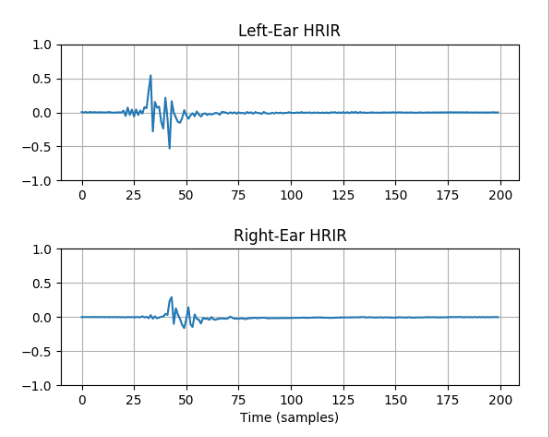
HRTFs utilize IR to create spatial audio experiences. The IR captures how sound changes as it travels through space and interacts with objects, including the listener’s head and ears.
- Convolution Process: In audio processing, convolution is applied where the audio signal is convolved with the HRTF to simulate the effect of a sound coming from a particular direction. This operation modifies the audio signal such that when played through headphones or speakers, it mimics the spatial characteristics that would be present in the physical environment.
- Building Sound Environments: For instance, when a sound engineer prepares a soundtrack for a film or a game, they use HRTFto place virtual sound cues accurately. This results in a more engaging experience, allowing the audience to perceive sounds as coming from specific directions relative to the listener.
Cone of Confusion

The Cone of Confusion is a geometric representation of areas where sounds can be mislocalized. Within this region, sounds originating from different sources may be perceived as coming from similar angles.
- Spatial Awareness: During audio playback, sounds that are located within this “cone” challenge the listener’s ability to tell where the source is actually positioned. This can lead to a less convincing auditory experience in immersive environments.
- Utilization of Head-Related Cues: To combat the effects of the cone of confusion, researchers and developers may introduce additional auditory cues through advanced signal processing techniques that enhance the localization of sound sources, ensuring a more accurate perception of spatial audio.
Decorrelation
Concept of Decorrelation
Decorrelation in spatial sound refers to the technique of transforming a mono signal into stereo output, creating a sense of space and depth. This process is essential for creating an immersive and diffuse ambient sound field, especially in a multi-channel sound system. The primary goal of decorrelation in spatial sound is to provide a more natural and realistic listening experience by simulating the acoustic properties of a real environment.
Effects on Sound Perception
When effectively implemented, decorrelation enhances the sense of spaciousness and immersion experienced by the listener. By using decorrelated signals, we reduce the likelihood of specific sound localization, leading to an enveloping auditory experience. This quality is beneficial in settings such as cinemas, virtual reality, and multi-channel environments.
However, it is critical that decorrelation is achieved without introducing significant timbral coloration or artifacts, which can happen if the underlying implementation is poorly designed. So, balance is key. The resulting sounds must maintain similarity to the original signal while achieving distinctiveness.
While decorrelation techniques can enhance spaciousness, it’s important to note that this processing may have some impact on the original signal. In certain cases, excessive decorrelation might introduce subtle timbral changes or create audible artifacts. Therefore, when applying decorrelation techniques, a balance must be struck between enhancing spatial perception and maintaining the integrity of the original audio. Carefully tuning decorrelation parameters to ensure the final effect enhances spaciousness without noticeably altering the original audio characteristics.
Creating Diffuse Sound Fields
Creating a diffuse sound field requires a thoughtful approach to signal decorrelation. For a robust ambient sound experience in a surround sound or 3D audio setup, sufficient decorrelated signals must be played back via an adequate number of loudspeakers.
If any pair of loudspeakers receive correlated signals, they may inadvertently produce a localizable phantom source, compromising the diffuse quality of the sound field.Proper design of decorrelation responses is essential to ensure that ambient signals maintain low ICC while still being similar to the original input.
Image Distance and Width
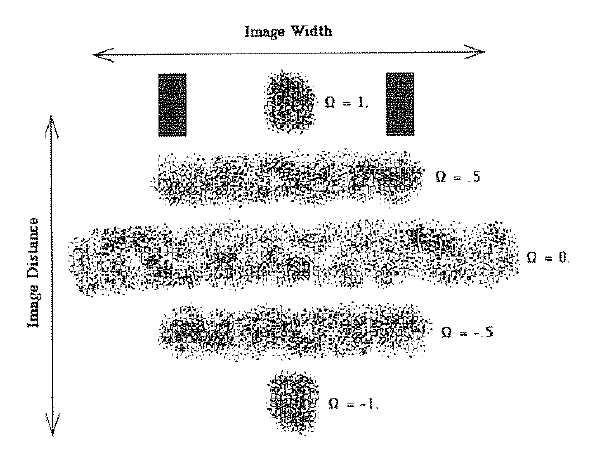
The manipulation of image distance and width is achieved through decorrelated signals. Image distance refers to the perceived distance from the listener to the sound sources, while image width describes how broadly sounds are perceived across the soundstage.
By cultivating a collection of decorrelated ambient signals, the perception of image distance and width in the listener’s experience. Adjustments to the decorrelation process can improve the spatial perception of sounds, making them appear to come from different locations in the surrounding environment.
Challenge of Externalization
Despite the advantages of decorrelated signals in creating immersive audio experiences, achieving true externalization. When listeners perceive sounds to originate from the environment rather than inside their heads, remains a huge technical challenge.
To enhance externalization, decorrelation techniques must be carefully refined. Particularly in the frequency domain. Decorrelation should be managed selectively across frequency ranges. Excessive decorrelation at low and high frequencies may lead to artifacts that could detract from the listening experience. Establishment of decorrelation filters must consider these factors to produce a seamless auditory experience.
Reverberator
Purpose and Function
The primary purpose of a reverberator is to simulate the natural reverberation that occurs in various acoustic environments. Reverberation refers to the persistence of sound in a space after the original sound source has stopped—this is essential in creating a sense of depth and realism in audio production. The reverberator enriches the auditory experience by adding ambiance to dry, direct sounds, making them sound fuller and more engaging.
In a well-balanced mix, the reverberation can help to blend individual sound elements, providing spatial cues that enhance the perception of distance and directionality. It is especially important in music production, film sound design, and virtual environments where immersion is necessary. With the appropriate application of reverberation, a sense of space can be introduced, allowing listeners to feel as though they are situated within a performance hall, concert venue, or any other environment.
Components of IR
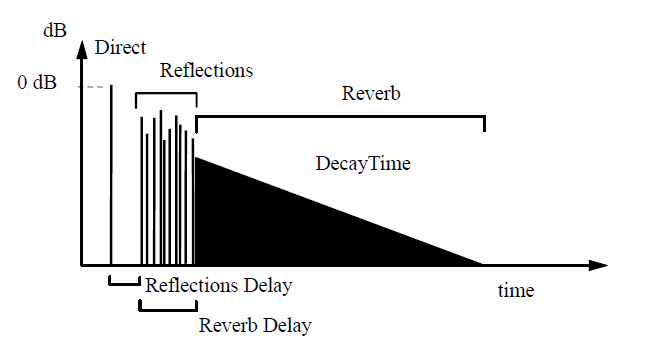
IR is a crucial element in modeling reverberation. It describes how a particular acoustic environment reacts to an instantaneous sound, and it consists of three main components:
- Direct Path: This is the initial sound that travels directly from the source to the listener without any reflections or echoes. It is crucial for clarity and intelligibility since it provides the listener with the foundational sound.
- Early Reflections: After the direct sound, early reflections are the first echoes that bounce off nearby surfaces (like walls, floors, and ceilings) and reach the listener. These reflections can significantly affect the perceived acoustics of a space, providing cues about the environment’s size and material properties.
- Reverberation: This component refers to the longer delay echoes that result from sound reflecting off various surfaces over time. Reverberation contributes to the richness and fullness of sound, as multiple delayed reflections blend together, creating a sense of envelopment.
Together, these components form the complete IR of a space and define the character of the reverberation applied to audio signals.
Common Reverberator Designs
Numerous algorithms and techniques have been developed to create artificial reverberation.
Some of the most common designs include:
All-pass Filters
All-pass filters are commonly used in reverberation algorithms to manipulate the phase of a signal without affecting its amplitude. By altering the phase relationship of the frequencies in the input signal, all-pass filters can create echoes without introducing noticeable coloration. This feature allows for the maintenance of tonal integrity while still achieving the desired reverberative effect.
The design of all-pass filters can be straightforward, typically implemented in digital signal processing with minimal computational overhead.
Comb Filters
Comb filters are another approach to generating reverb effects. They derive their name from the frequency response that resembles the teeth of a comb due to the regular notches in the spectrum. By combining delayed versions of the input signal, comb filters can create a series of peaks and troughs in the frequency response, which contributes to the perception of an echoing sound.
Although comb filters can add characteristic coloration to reverb, they also allow sound designers to create unique flexibility in shaping the reverb tail. However, the distinct tonal signature may not be suitable for all applications, which is why careful selection and application of techniques are essential.
Reverberation Time and Tail Characteristics
Reverberation time and RT60 is a crucial parameter that defines how long it takes for the sound to decay by 60 dB after the source has stopped. Specifically, it measures the time required for the intensities of reflected sound rays to be down 60dB from the direct path sound ray This measurement is essential for characterizing different environments and is typically adjusted in a mix to simulate specific acoustic scenarios.
Other tail characteristics, such as diffusion and density of the reverb, can also be manipulated to create the desired auditory experience. For example, a tighter reverb with a quick decay can feel more intimate, while a longer, more diffuse reverb can provide a sense of grandeur and openness.
Cross-Talk Cancellation (CTC)
Principles of Cross-Talk Cancellation

Cross-Talk Cancellation (CTC) is a sophisticated audio processing technique designed to minimize the crosstalk that occurs in stereo and multi-channel audio systems. Crosstalk refers to the phenomenon where sound from the left channel is heard by the right ear, or sound from the right channel is heard by the left ear.
CTC employs signal processing algorithms to use filters that cancel out the crosstalk signals while preserving the original intended signals on each side, typically by introducing a time delay. By ensuring that only the intended audio signals reach each ear, CTC enhances the spatial perception of sound sources, making them appear clearer and more distinct.
Application in Stereo Speaker Systems
In stereo systems, CTC is particularly valuable as it helps to maintain a clear separation between the left and right channels. When audio is reproduced through speakers positioned close to the listener, crosstalk becomes a significant issue. This is because sound waves from one speaker can reach the opposite ear, resulting in muddied stereo imaging.
By implementing CTC, the signal for each channel is processed to include delays and phase magnitude, allowing for an effective cancellation of the sound from the other channel. The result is a more established phantom image between the speakers, providing a clearer and more immersive listening experience.
Inverse Filtering in CTC
Inverse filtering is a fundamental technique employed in CTC systems. It involves constructing a filter based on the characteristics of the listener’s auditory system and the room acoustics. By using impulse responses derived from the setup, the audio processor can create cancellation signals that effectively negate unwanted sound interference from the opposite channel.
Although inverse filtering is a powerful technique, it faces several challenges in practical applications. Firstly, system stability can be affected, especially when dealing with complex or changing acoustic environments. Secondly, inverse filtering is highly sensitive to environmental changes; even slight movements in listener position can significantly impact its effectiveness.
Benefits for Spatial Sound
The implementation of CTC provides several notable benefits for spatial sound reproduction:
- Enhanced Sound Localization: By minimizing crosstalk and preserving the integrity of the signals on each respective side, CTC helps to establish clearer sound localization cues, allowing listeners to perceive the position of sound sources in the audio field more accurately.
- Improved Sound Quality: CTC contributes to overall sound quality enhancement, as it reduces the blending of sound from separate channels, resulting in a more defined and immersive listening experience.
- Extended Listening Areas: CTC can help establish a wider “sweet spot” for optimal listening positions, making it easier for multiple listeners to enjoy the spatial characteristics of the audio without compromise.
Conclusion
Summary of Spatial Sound Technologies
Throughout this article, we’ve explored the intricate world of spatial audio, from its fundamental principles to its diverse applications across various industries. We’ve touched on key concepts such as Interaural Time Difference (ITD) and Interaural Level Difference (ILD), providing readers with a foundational understanding of how we perceive sound in three-dimensional space.
However, it’s crucial to remember that what we’ve discussed in this article is just the tip of the iceberg. The field of spatial audio is vast and constantly evolving. The successful implementation of these spatial audio technologies relies heavily on the specific hardware and software capabilities of each company, and there’s a wealth of research and innovation happening behind the scenes.
For those intrigued by the possibilities of spatial audio and interested in concrete applications or deeper technical insights, we encourage further exploration. The journey into spatial audio is an exciting one, full of potential for creating more engaging, immersive, and realistic sound experiences.
JAZZ HIPSTER's Expertise in Spatial Audio Solutions
As we look to the future, the prospects for spatial sound are incredibly exciting. The growing demand for immersive experiences in various contexts – from home entertainment to gaming, live events – presents tremendous opportunities for audio brands. By integrating advanced spatial audio solutions, brands can significantly enhance their product offerings, creating unique value propositions that resonate with consumers seeking more engaging and realistic sound experiences.
JAZZ HIPSTER is committed to empowering brands through our expertise in spatial sound technologies. Our collaborations with industry leaders like MTK and Dolby have enabled us to develop innovative products that harness the full potential of spatial audio technologies. By continuing to invest in research, development, and partnerships, we’re poised to shape the future of spatial audio, creating immersive soundscapes that will redefine how we interact with the world around us.
In this rapidly advancing field, one thing is clear: the era of spatial sound has only just begun, and JAZZ HIPSTER is excited to be at the helm, guiding the industry towards new horizons in audio technology.
References
- [1] Report – Recent Advances in the Spatially Oriented Format for Acoustics
- [2] Report – Spatially Oriented Format for Acoustics 2.1:Introduction and Recent Advances
- [3] Report – Stereo Signal Decomposition and Upmixing to Surround and 3D Audio


